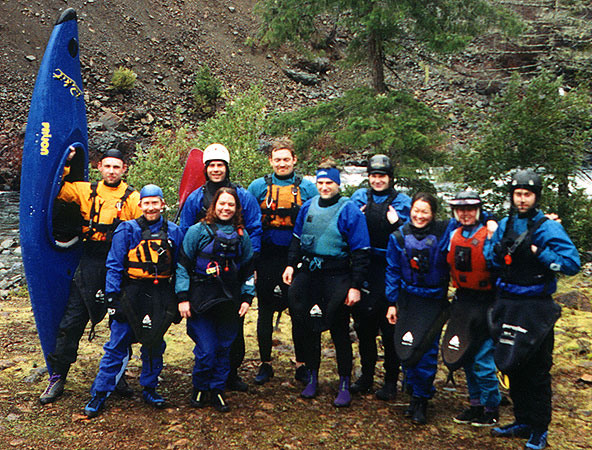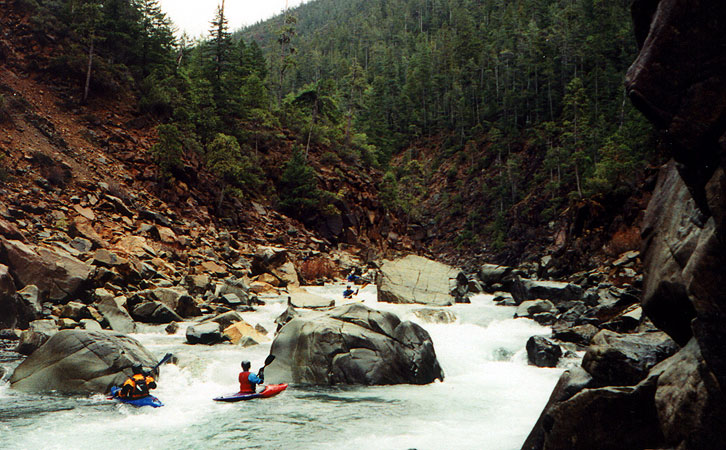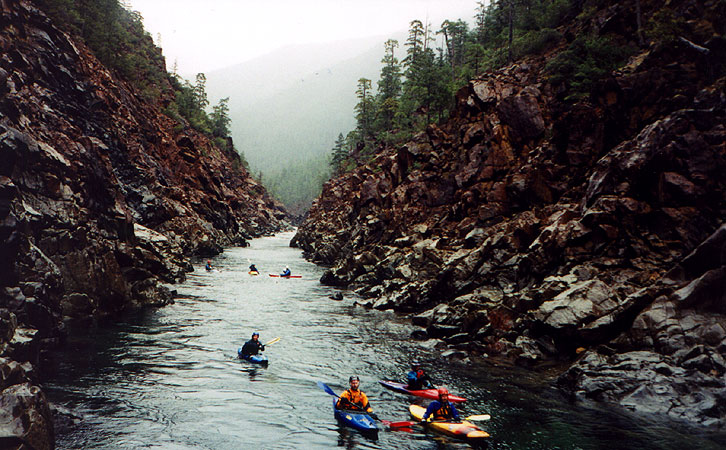
The North Fork of the Smith River shouldn't be missed if you are in the area. This scenic twelve mile run is quite remote and requires a two hour shuttle, but it is well worth the effort. The river flows through a rugged canyon with many sights to see, including stunted old growth trees and the endangered carnivorous Pitcher Plant. I thoroughly enjoyed my first time through this canyon, and though I wished for more water at times the wildness of the place more than made up for it.
We ran the North Fork on the second day of our Smith River trip. Eleven of us from all over Oregon had fled winter drought conditions up north to find solace in the ever-plentiful Smith River drainage. Luckily it had rained a couple of inches a few days prior to our arrival, so the North Fork was (just) runnable. We hired shuttle drivers to run our cars downstream so we would have the majority of the day to enjoy the canyon. Only a couple of boaters in our group had done the run previously (Kim Bates and Steve Stuckmeyer) so it promised to be an interesting day.
The Smith River Gang...
From left to right: Steve Stuckmeyer, Mike Haley, Pete Giordano, Kristin Brown, Tom 'International Man of Mystery' Powers, John Whaley, Brad Cascagnette, Tracy Shiozawa, Kim Bates, and Gabe Flock.

Our group ran the gamut from first year boaters to old-school experts, but that is the beauty of this run; it has something for everyone! We put on and drifted slowly downstream through a deep, clear pool towards the first set of rapids. Some folks scouted, some folks didn't, but eventually we got into a nice rhythm and assumed a leisurely pace down the river.
Brad runs one of the more difficult rapids on the North Fork Smith while Kim and Steve watch from below.

I suppose it would be easy to rush down this canyon as the rapids are straightforward and the river is free of wood, but you would be missing out if you did. We moved slowly but steadily downstream, and once it became apparent that we would have plenty of daylight we took the time to play and explore. Kim and I spotted some rare carnivorous Pitcher plants at one point and hopped out to shoot some pictures. It is a shame that we had to come so far to see these endangered plants, but it is nice to know they are sheltered from the missteps of mankind in this rugged and wild place.
The endangered Pitcher Plant. This plant eats insects that crawl down inside it's neck, lured by the sweet nectar inside. Once within the slender confines of the stem the insects are trapped because the hairs pointing downward that allowed them easy entry prevent their escape.

The North Fork flows through one of the most rugged river canyons I have ever seen. The rock forming the walls of the gorges and canyon is shattered and jagged, giving the impression of cataclysmic forces at work. The trees are also relatively small, (especially considering they have never been logged) as the soil lacks nutrients and is naturally poisonous in places.
Coming through one of the North Fork's Gorges.

Towards the end of the run the geology gets really interesting and we explored several shallow caves that have formed in the canyon walls. In addition, some of the boulders form wild conglomerate sculptures that I regret not taking photos of...
The group checks out a cave with a trickle of water dropping in from above. If you look carefully you can see large clusters of Pitcher Plants lining the top rim of the cave just below the trees..

We were all definitely tired at the end of the run after playing and drifting for so many miles, but it was a day well spent. If you are in area, the North Fork of the Smith shouldn't be missed- bring your playboat, pack a lunch, and enjoy!!